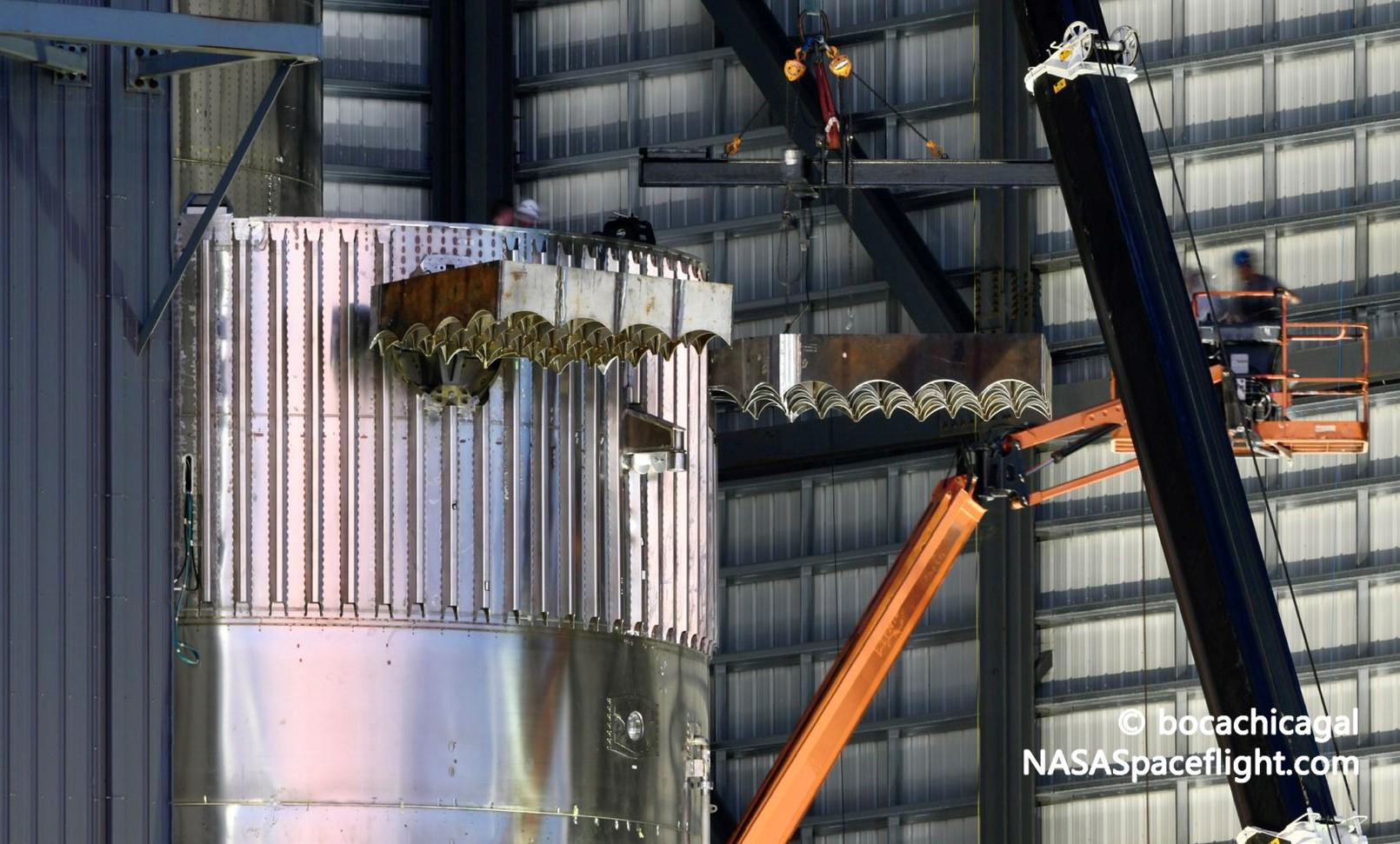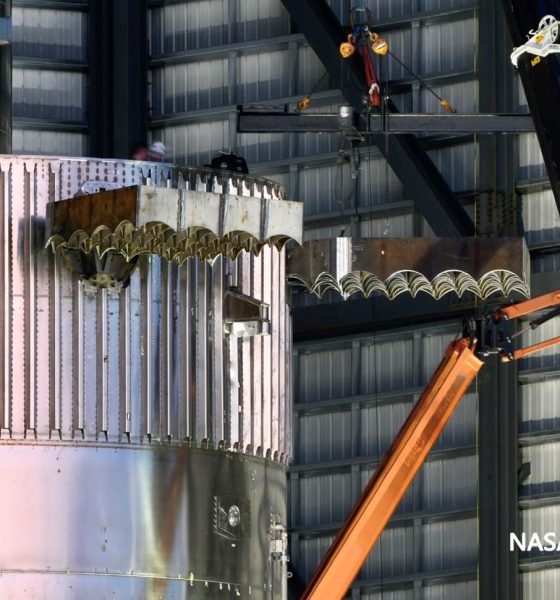

News
SpaceX outfits first orbital-class Starship booster with grid fins, Raptor engines
In the space of two days, SpaceX has outfitted Starship’s first orbital-class Super Heavy booster with four car-sized grid fins, stacked the rocket to its full height, and begun the process of installing up to 29 Raptor engines.
As part of what CEO Elon Musk has described as a “Starbase Surge,” SpaceX has reportedly sent hundreds of employees normaly stationed in California, Florida, and Central Texas to Boca Chica. There, SpaceX has been working for months to build Starship’s first orbital launch pad and first orbital-class ship and booster and prepare all three for an inaugural “Orbital Test Flight” as quickly as possible. Originally scheduled to occur no later than July 2021, Musk’s extremely ambitious target unsurprisingly came and went but SpaceX appears to be well on its way to an “aim for the Moon; miss; fall among the stars” situation as all the parts of Starship’s orbital launch debut begin to come together.
In the last few days, it’s become abundantly clear that SpaceX is likely moving faster than even its most optimistic followers expected.
On July 30th, after less than two days of assembly, Super Heavy Booster 4’s completed (upper) methane tank stack – 13 rings and ~25m (85 ft) tall was briefly rolled out of SpaceX’s Boca Chica ‘high bay.’ A few hours later, the booster tank was rolled back in and SpaceX technicians kicked off the installation of four car-sized steel grid fins. A day and a half later, all four fins were installed.
Unlike the famous cast titanium grid fins on Falcon boosters, Super Heavy’s fins are built out of welded steel (much heavier but magnitudes cheaper) and not designed to retract, meaning that they will remain in their deployed configuration at all times. While also allowing for a much simpler design, B4’s fixed (but rotatable) grid fins will also make it dramatically easier to catch Super Heavy boosters – as Elon Musk has said is the plan – on their grid fins using a giant tower with arms.
Almost immediately after the last grid fin was installed, SpaceX moved Super Heavy B4’s larger (aft) liquid oxygen tank stack onto a stand optimized for transport and stacked the newly finned methane tank on top of the rocket, raising it to its full ~65m (~215 ft) height. After stacking, it takes a team of SpaceX welders at least several hours to join the two steel booster sections into one monolithic rocket.
At the same time as technicians were working to complete Booster 4’s airframe, SpaceX accepted delivery of no less than five Raptor engines, raising the total number of engines delivered in the last five days to at least 18 – including two Raptor Vacuum variants for Starship S20.
In a sign of the breakneck pace SpaceX is working at, teams began installing Raptor engines on Booster 4 before its two halves were fully welded together. In a matter of hours, no less than 12 Raptor Boost (RB) engines have been rolled out of one of SpaceX’s three Boca Chica factory tents and lined up for installation on the first flightworthy Super Heavy. Requiring 29 engines total, it’s not implausible that SpaceX is attempt to fully outfit Booster 4 with all of its Raptors before rolling the rocket down the road to the orbital launch pad.
According to Elon Musk, SpaceX could attempt to install the Super Heavy booster on the pad’s launch mount/table (integrated just days ago) as early as “~Tuesday” and the company has already filed for transport-related road closure on Monday afternoon.

Elon Musk
Elon Musk just said some crazy stuff about the Tesla Roadster

Elon Musk appeared on the Moonshots podcast with Peter Diamandis today to discuss AGI, U.S. vs. China, Tesla, and some other interesting topics, but there was some discussion about the upcoming unveiling of the Roadster, the company’s electric supercar that will arrive several years after it was initially slated for release.
Musk made some pretty amazing claims about the Roadster; we already know it is supposed to be lightning-fast and could even hover, if Tesla gets everything to happen the way it wants to. However, the car has some pretty crazy capabilities, some of which have not even been revealed.
On the podcast, Musk said:
“This is not a…safety is not the main goal. If you buy a Ferrari, safety is not the number one goal. I say, if safety is your number one goal, do not buy the Roadster…We’ll aspire not to kill anyone in this car. It’ll be the best of the last of the human-driven cars. The best of the last.”
🚨 Elon on the Roadster unveiling, scheduled for April 1:
— TESLARATI (@Teslarati) January 6, 2026
Musk makes a good point: people who buy expensive sports cars with ridiculous top speeds and acceleration rates do not buy them to be safe. They hope they are safe in case of an emergency or crash, but safety is not at the forefront of their thoughts, because nobody buys a car thinking they’ll crash it.
The Roadster is truly going to push the limits and capabilities of passenger vehicles; there’s no doubt about that. Tesla plans to show off the new version car for the first time on April 1, and Musk has only hinted at what is possible with it.
Musk said back in November:
“Whether it’s good or bad, it will be unforgettable. My friend Peter Thiel once reflected that the future was supposed to have flying cars, but we don’t have flying cars. I think if Peter wants a flying car, he should be able to buy one…I think it has a shot at being the most memorable product unveiling ever. [It will be unveiled] hopefully before the end of the year. You know, we need to make sure that it works. This is some crazy technology in this car. Let’s just put it this way: if you took all the James Bond cars and combined them, it’s crazier than that.”
Production is set to begin between 12 and 18 months after the unveiling, which would put the car out sometime in 2027. Hopefully, Tesla is able to stay on track with the scheduling of the Roadster; many people have been waiting a long time for it.
News
Tesla launches hiring for Robotaxi program in its twentieth country
Overall, the hiring signals Tesla’s aggressive timeline for global dominance in autonomous mobility.

Tesla has launched a hiring initiative for its Robotaxi program in its twentieth country, as the company posted two new jobs in Thailand this week.
Tesla is hiring in Bangkok and Kowloon for the Vehicle Operator position, which is related to data collection, and is the first in Thailand, but the twentieth country overall, as the company tries to expand into other markets.
🚨 BREAKING: Tesla is hiring additional full-time Vehicle Operators in Bangkok, Thailand.
Previous openings were 6-month, part-time roles. These are equivalent to AI Safety Operator roles in the U.S. pic.twitter.com/R6LzoU1bos— Tesla Yoda (@teslayoda) January 5, 2026
Tesla has had active job postings for Vehicle Operator positions in the United States, India, Israel, Taiwan, Germany, the Czech Republic, Hungary, the UK, Finland, Switzerland, Sweden, the Netherlands, Austria, Spain, Norway, Italy, and Turkey in past listings.
These postings are not all currently available, likely because the roles have been filled.
Thailand is the most recent, and broadens the company’s potential path to expanding its ride-hailing program, which is only active in the United States in Austin, Texas, and the California Bay Area, so far.
These roles typically involve data collection, which assists in improving Autopilot and Full Self-Driving operation. Tesla’s self-driving programs utilize real-world data that is accumulated and stored, observing vehicle and traffic behavior, as well as tendencies that are performed by human drivers to help increase safety and overall performance.
Overall, the hiring signals Tesla’s aggressive timeline for global dominance in autonomous mobility. Although the company has several high-profile rivals and competitors in the field, it has established itself as a main player and a leader in the development of autonomous technology, especially in the U.S., as its FSD suite is refined on almost a weekly basis.
The Full Self-Driving suite is available in seven countries and territories currently, including the U.S., Canada, China, Mexico, Puerto Rico, Australia, and New Zealand. Its biggest goal for expansion is currently the European market, where regulatory hurdles have been the main bottleneck prolonging its launch on the continent.
Tesla has performed months of testing in various European countries, including France and Spain, and does have support in some areas from various regulatory agencies. However, the company is hoping to get through this red tape and offer its suite in Europe for the first time, hopefully this year.
News
Tesla China rolls out Model Y upgrades, launches low-interest financing
These strategies are aimed at improving the ownership experience and keeping vehicle pricing competitive in the world’s largest electric vehicle market.

Tesla has rolled out minor updates to the five-seat Model Y in China, upgrading the vehicle’s center display to a higher-resolution 16-inch 2K screen. The electric vehicle maker also introduced attractive financing options, including 7-year low-interest rates, to offset the new purchase tax on EVs.
These strategies are aimed at improving the ownership experience and keeping vehicle pricing competitive in the world’s largest electric vehicle market.
Five-seat Model Y gets larger, better display
With its recent update, all three variants of the five-seat Model Y now feature an upgraded 16-inch 2K resolution center display, which replaces the vehicle’s previous 15.4-inch 1080p panel. This screen was already used in the six-seat Model Y L, and it offered improved visual clarity. Tesla China has also updated the Model Y’s headliner to black, giving the vehicle a sleeker appearance.
Prices of the five-seat Model Y remain unchanged at RMB 263,500, RMB 288,500, and RMB 313,500 for the respective trims. This update enhances the cabin experience as domestic rivals are already adopting high-resolution screens. As noted in a CNEV Post report, some domestic automakers have begun rolling out vehicles equipped with 3K-resolution displays.
New financing offers
Tesla also launched ultra-long-term financing offers for its locally produced models in China, which include the Model 3 sedan, the five-seat Model Y, and the six-seat Model Y L, through January 31, 2026. The 7-year option features an annualized fee rate as low as 0.5%, which is equivalent to 0.98% interest. This is expected to save customers up to RMB 33,479 ($4,790) compared to standard rates.
A 5-year zero-interest plan is also available, and it has been extended to the Tesla Model Y L for the first time. These incentives help offset China’s new 5% purchase tax on New Energy Vehicles (NEVs) in 2026-2027. Some of Tesla’s rivals in China have announced in recent months that they would be covering the purchase tax owed by buyers early this year.








